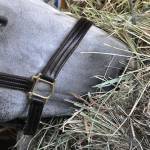Hay Cubes and Pellets for Horses

Hay pellets and cubes made from good-quality forage can help satisfy a horse’s nutritional requirements, providing adequate fiber to keep the gastrointestinal tract fully functioning.
Hay that’s going to be made into pellets or cubes is sun-cured and ground, then mixed with a binder and set into its final cube or pellet form. Hay made into pellets goes through more intensive grinding than hay intended for cubes.
Cubes and pellets present certain advantages when compared to more traditional hay. Like other processed feeds, the guaranteed levels of protein, fat, and fiber must be printed on the bag or feed tag, ensuring consistency of the product. In contrast, the quality of baled hay can differ from field to field, or even within the same field.
Cubes and pellets are also easier to measure, feed, and store than baled hay, and the minimal dust and ease of soaking makes them ideal for horses with respiratory problems.
On the downside, the purity of cubes and pellets can be difficult to decipher, as it’s more difficult to spot foreign matter that may have filtered in. Weeds are easy to see in loose hay, but impossible to pinpoint in cubes and pellets. The best way to avoid quality issues is by buying pellets or cubes from a reputable dealer.
Another potential issue is the speed with which horses can consume their allotment of cubes or pellets, potentially leading to boredom-induced behaviors such as wood-chewing. A small amount of long-stemmed forage, perhaps one-half to one pound daily, should be offered to keep horses on completely cubed or pelleted forages busy.
Read more:








